FIDE Laws of Chess |
| PREFACE |
| The Laws of Chess cannot
cover all possible situations that may arise during a game, nor can
they regulate all administrative questions. Where cases are not precisely
regulated by an Article of the Laws, it should be possible to reach
a correct decision by studying analogous situations, which are discussed
in the Laws. The Laws assume that arbiters have the necessary competence,
sound judgement and absolute objectivity. Too detailed a rule might
deprive the arbiter of his freedom of judgement and thus prevent him
from finding the solution to a problem dictated by fairness, logic and
special factors.
FIDE appeals to all chess players and federations to
accept this view.
A member federation is free to introduce more detailed
rules provided they:
- do not conflict in any way with the official FIDE Laws of Chess
- are limited to the territory of the federation in question; and
- are not valid for any FIDE match, championship or qualifying event,
or for a FIDE title or rating tournament.
|
| BASIC RULES OF PLAY |
| Article 1: The nature and objectives of
the game of chess |
| 1.1 |
The game of chess is played between
two opponents who move their pieces alternately on a square board called
a `chessboard`. The player with the white pieces commences the game.
A player is said to `have the move`, when his opponent`s move has been
made. |
| 1.2 |
The objective of each player is to
place the opponent`s king `under attack` in such a way that the opponent
has no legal move. The player who achieves this goal is said to have
`checkmated` the opponent`s king and to have won the game. Leaving one`s
own king under attack, exposing one`s own king to attack and also `capturing`
the opponent`s king are not allowed. The opponent whose king has been
checkmated has lost the game. |
| 1.3 |
If the position is such that neither
player can possibly checkmate, the game is drawn. |
| Article 2: The initial position of the pieces
on the chessboard |
| 2.1 |
The chessboard is composed of an 8x8
grid of 64 equal squares alternately light (the `white` squares) and
dark (the `black` squares).
The chessboard is placed between the players in such a way that the
near corner square to the right of the player is white. |
| 2.2 |
At the beginning of the game one player
has 16 light-coloured pieces (the `white` pieces); the other has 16
dark-coloured pieces (the `black` pieces): These pieces are as follows:
| A white king, usually indicated by the symbol |
 |
| A white queen, usually indicated by the symbol |
 |
| Two white rooks, usually indicated by the symbol |
 |
| Two white bishops, usually indicated by the symbol |
 |
| Two white knights, usually indicated by the symbol |
 |
| Eight white pawns, usually indicated by the symbol |
 |
| A black king, usually indicated by the symbol |
 |
| A black queen, usually indicated by the symbol |
 |
| Two black rooks, usually indicated by the symbol |
 |
| Two black bishops, usually indicated by the symbol |
 |
| Two black knights, usually indicated by the symbol |
 |
| Eight black pawns, usually indicated by the symbol |
 |
|
| 2.3 |
The initial position of the pieces
on the chessboard is as follows:

|
| 2.4 |
The eight vertical columns of squares
are called `files`. The eight horizontal rows of squares are called
ranks`. A straight line of squares of the same colour, touching corner
to corner, is called a `diagonal`. |
| Article 3: The moves of the pieces |
| 3.1 |
It is not permitted to move a piece
to a square occupied by a piece of the same colour. If a piece moves
to a square occupied by an opponent`s piece the latter is captured and
removed from the chessboard as part of the same move. A piece is said
to attack an opponent`s piece if the piece could make a capture on that
square according to Articles 3.2 to 3.8.
A piece is considered to attack a square, even if such a piece is constrained
from moving to that square because it would then leave or place the
king of its own colour under attack. |
| 3.2 |
The bishop may move to any square along
a diagonal on which it stands.

|
| 3.3 |
The rook may move to any square along
the file or the rank on which it stands.
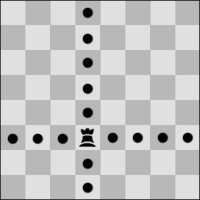
|
| 3.4 |
The queen may move to any square along
the file, the rank or a diagonal on which it stands.
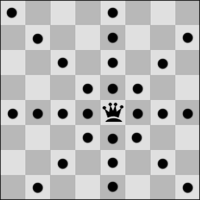
|
| 3.5 |
When making these moves the bishop,
rook or queen may not move over any intervening pieces. |
| 3.6 |
The knight may move to one of the squares
nearest to that on which it stands but not on the same rank, file or
diagonal.
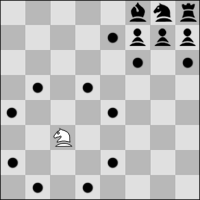
|
| 3.7 |
-
The pawn may move forward to the unoccupied square
immediately in front of it on the same file, or
-
on its first move the pawn may move as in (a);
alternatively it may advance two squares along the same file provided
both squares are unoccupied, or
-
the pawn may move to a square occupied by an opponent`s
piece, which is diagonally in front of it on an adjacent file, capturing
that piece.
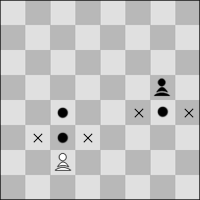
-
A pawn attacking a square crossed by an opponent`s
pawn which has advanced two squares in one move from its original
square may capture this opponent`s pawn as though the latter had
been moved only one square. This capture is only legal on the move
following this advance and is called an `en passant` capture.
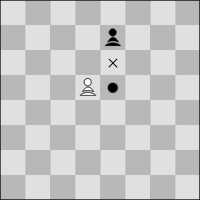
-
When a pawn reaches the rank furthest from its
starting position it must be exchanged as part of the same move
for a new queen, rook, bishop or knight of the same colour. The
player`s choice is not restricted to pieces that have been captured
previously. This exchange of a pawn for another piece is called
`promotion` and the effect of the new piece is immediate.
|
| 3.8 |
There are two different ways of moving the king, by:
-
moving to any adjoining square not attacked by
one or more of the opponent`s pieces.

The opponent`s pieces are considered to attack
a square, even if such pieces cannot themselves move.
or
-
`castling`. This is a move of the king and either
rook of the same colour on the same rank, counting as a single move
of the king and executed as follows: the king is transferred from
its original square two squares towards the rook, then that rook
is transferred to the square the king has just crossed.

(1) The right for castling has been lost:
-
if the king has already moved, or
-
with a rook that has already moved
(2) Castling is prevented temporarily
-
if the square on which the king stands, or
the square which it must cross, or the square which it is to
occupy, is attacked by one or more of the opponent`s pieces.
-
if there is any piece between the king and
the rook with which castling is to be effected.
|
| 3.9 |
The king is said to be `in check` if
it is attacked by one or more of the opponent`s pieces, even if such
pieces are constrained from moving to that square because they would
then leave or place their own king in check. No piece can be moved that
will expose its own king to check or leave its own king in check. |
| Article 4: The act of moving the pieces
|
| 4.1 |
Each move must be made with one hand
only. |
| 4.2 |
Provided that he first expresses his
intention (e.g. by saying "j`adoube" or "I adjust"), the player having
the move may adjust one or more pieces on their squares. |
| 4.3 |
Except as provided in Article 4.2,
if the player having the move deliberately touches on the chessboard
-
one or more of his own pieces, he must move the
first piece touched that can be moved, or
-
one or more of his opponent`s pieces, he must capture
the first piece touched, which can be captured, or
-
one piece of each colour, he must capture the opponent`s
piece with his piece or, if this is illegal, move or capture the
first piece touched which can be moved or captured. If it is unclear,
whether the player`s own piece or his opponent`s was touched first,
the player`s own piece shall be considered to have been touched
before his opponent`s.
|
| 4.4 |
-
If a player deliberately touches his king and rook
he must castle on that side if it is legal to do so.
-
If a player deliberately touches a rook and then
his king he is not allowed to castle on that side on that move and
the situation shall be governed by Article 4.3(a).
-
If a player, intending to castle, touches the king
or king and rook at the same time, but castling on that side is
illegal, the player must make another legal move with his king which
may include castling on the other side. If the king has no legal
move, the player is free to make any legal move.
-
If a player promotes a pawn, the choice of the
piece is finalised, when the piece has touched the square of promotion.
|
| 4.5 |
If none of the pieces touched can be
moved or captured, the player may make any legal move. |
| 4.6 |
When, as a legal move or part of a
legal move, a piece has been released on a square, it cannot then be
moved to another square. The move is considered to have been made when
all the relevant requirements of Article 3 have been fulfilled.
-
in the case of a capture, when the captured piece
has been removed from the chessboard and the player, having placed
his own piece on its new square, has released this capturing piece
from his hand;
-
in the case of castling, when the player`s hand
has released the rook on the square previously crossed by the king.
When the player has released the king from his hand, the move is
not yet made, but the player no longer has the right to make any
move other than castling on that side, if this is legal;
-
in the case of the promotion of a pawn, when the
pawn has been removed from the chessboard and the player`s hand
has released the new piece after placing it on the promotion square.
If the player has released from his hand the pawn that has reached
the promotion square, the move is not yet made, but the player no
longer has the right to play the pawn to another square.
|
| 4.7 |
A player forfeits his right to a claim
against his opponent`s violation of Article 4.3 or 4.4, once he deliberately
touches a piece. |
| Article 5: The completion of the game |
| 5.1 |
-
The game is won by the player who has checkmated
his opponent`s king. This immediately ends the game, provided that
the move producing the checkmate position was a legal move.
-
The game is won by the player whose opponent declares
he resigns. This immediately ends the game.
|
| 5.2 |
-
The game is drawn when the player to move has no
legal move and his king is not in check. The game is said to end
in `stalemate`. This immediately ends the game, provided that the
move producing the stalemate position was legal.
-
The game is drawn when a position has arisen in
which neither player can checkmate the opponent`s king with any
series of legal moves. The game is said to end in a `dead position`.
This immediately ends the game, provided that the move producing
the position was legal.
-
The game is drawn upon agreement between the two
players during the game. This immediately ends the game. (See Article
9.1)
-
The game may be drawn if any identical position
is about to appear or has appeared on the chessboard at least three
times. (See Article 9.2)
-
The game may be drawn if each player has made at
least the last 50 consecutive moves without the movement of any
pawn and without any capture. (See Article 9.3)
|




















